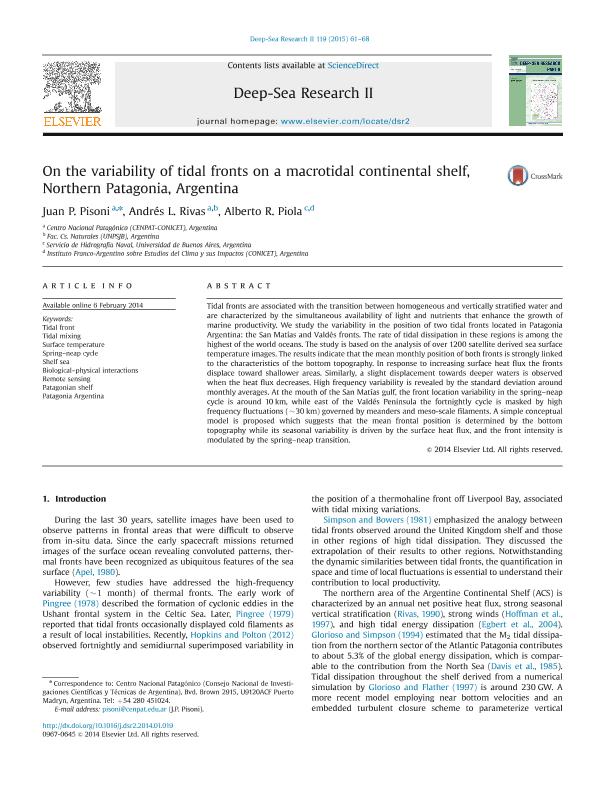Mostrar el registro sencillo del ítem
dc.contributor.author
Pisoni, Juan Pablo

dc.contributor.author
Rivas, Andres Lujan

dc.contributor.author
Piola, Alberto Ricardo

dc.date.available
2018-04-04T17:14:59Z
dc.date.issued
2015-07
dc.identifier.citation
Pisoni, Juan Pablo; Rivas, Andres Lujan; Piola, Alberto Ricardo; On the variability of tidal fronts on a macrotidal continental shelf, Northern Patagonia, Argentina; Elsevier; Deep Sea Research Part II: Topical Studies in Oceanography; 119; 7-2015; 61-68
dc.identifier.issn
0967-0645
dc.identifier.uri
http://hdl.handle.net/11336/40719
dc.description.abstract
Tidal fronts are associated with the transition between homogeneous and vertically stratified water and characterized by the simultaneous availability of light and nutrients that enhance the growth of marine productivity. We study the variability in the position of two tidal fronts located in Patagonia Argentina: the San Matías and Valdés fronts. The rate of tidal dissipation in these regions is among the highest of the world ocean. The study is based on the analysis of over 1200 satellite derived sea surface temperature images. The results indicate that the mean monthly position of both fronts is strongly linked to the characteristics of the bottom topography. In response to increasing surface heat flux the fronts displace toward shallower areas. Similarly, a slight displacement towards deeper waters is observed when the heat flux decreases. High frequency variability is revealed by the standard deviation around monthly averages. At the mouth of San Matías gulf, the front location variability in the spring-neap cycle is around 10 km, while east of Valdés Peninsula the fortnightly cycle is masked by high frequency fluctuations (~30 km) governed by meanders and meso-scale filaments. A simple conceptual model is proposed that suggests that the mean frontal position is determined by the bottom topography while its seasonal variability is driven by the surface heat flux, and the front intensity is modulated by the spring-neap transition.
dc.format
application/pdf
dc.language.iso
eng
dc.publisher
Elsevier

dc.rights
info:eu-repo/semantics/openAccess
dc.rights.uri
https://creativecommons.org/licenses/by-nc-sa/2.5/ar/
dc.subject
Tidal Front
dc.subject
Tidal Mixing
dc.subject
Spring-Neap Cycle
dc.subject
Patagonian Shelf
dc.subject.classification
Meteorología y Ciencias Atmosféricas

dc.subject.classification
Ciencias de la Tierra y relacionadas con el Medio Ambiente

dc.subject.classification
CIENCIAS NATURALES Y EXACTAS

dc.title
On the variability of tidal fronts on a macrotidal continental shelf, Northern Patagonia, Argentina
dc.type
info:eu-repo/semantics/article
dc.type
info:ar-repo/semantics/artículo
dc.type
info:eu-repo/semantics/publishedVersion
dc.date.updated
2018-03-28T18:13:01Z
dc.journal.volume
119
dc.journal.pagination
61-68
dc.journal.pais
Países Bajos

dc.journal.ciudad
Amsterdam
dc.description.fil
Fil: Pisoni, Juan Pablo. Consejo Nacional de Investigaciones Científicas y Técnicas. Centro Nacional Patagónico; Argentina
dc.description.fil
Fil: Rivas, Andres Lujan. Consejo Nacional de Investigaciones Científicas y Técnicas. Centro Nacional Patagónico; Argentina. Universidad Nacional de la Patagonia; Argentina
dc.description.fil
Fil: Piola, Alberto Ricardo. Ministerio de Defensa. Armada Argentina. Servicio de Hidrografía Naval; Argentina. Consejo Nacional de Investigaciones Científicas y Técnicas; Argentina
dc.journal.title
Deep Sea Research Part II: Topical Studies in Oceanography

dc.relation.alternativeid
info:eu-repo/semantics/altIdentifier/url/http://www.sciencedirect.com/science/article/pii/S0967064514000332
dc.relation.alternativeid
info:eu-repo/semantics/altIdentifier/doi/http://dx.doi.org/10.1016/j.dsr2.2014.01.019
Archivos asociados
